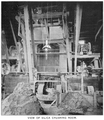File:Silica crushing mill for Manhès-David converter lining.png

Original file (1,858 × 2,150 pixels, file size: 2.77 MB, MIME type: image/png)
| This is a file from the Wikimedia Commons. Information from its description page there is shown below. Commons is a freely licensed media file repository. You can help. |
Summary
| DescriptionSilica crushing mill for Manhès-David converter lining.png |
Français : Broyeur de silice pour la confection du revêtement réfractaire des convertisseurs Manhès-David.
English: Silica crushing mill for Manhès-David converter lining.
Text appearing in the book BESSEMERIZING OF 45 TO 50 PER CENT. COPPER MATTE. The engravings represented on the following three pages are
made from photographs taken at the converter plant of the Anaconda Copper Mining Company, where a 45 to 50 per cent, matte is converted into about 99 per cent, metallic copper by means of twelve huge converters running continuously and producing over 225 tons of blister copper in twenty-four hours. Since the erection of the first converter in Butte City, 1884, a new era in the history of copper production can be dated, which together with the increased demand and a great many important and highly interesting improvements of late years have carried this metal to the very front. VIEW OF SILICA CRUSHING ROOM. The presence of small particles of blister copper in the escaping gases indicates to the converter tender that the charge is ready for casting. Directly back of the converter is located a stack and hood which connects with the dust chamber and receives the sulphurous gases as well as part of the slag discharged from the converter. The silica lining is omposed of about 28 per cent, fireclay and 72 per cent, crushed quartz. The quartz is reduced by crushers and rolls and afterwards mixed with the fire-clay in Chili mills as illustrated in the above engraving. The silica lining, attacked by the ferrous oxide will gradually decrease in thickness until relining and exchange of converter becomes necessary. Twenty-four extra converters are therefore always kept on hand. |
| Date | |
| Source | Catalogue no. 1, presented by the Anaconda Copper Mining Co., foundry department, manufacturers of mining, milling, concentrating and smelting machinery |
| Author | Anaconda Company |
Licensing
| Public domainPublic domainfalsefalse |
This work is in the public domain in the United States because it was published (or registered with the U.S. Copyright Office) before January 1, 1929.
Public domain works must be out of copyright in both the United States and in the source country of the work in order to be hosted on the Commons. If the work is not a U.S. work, the file must have an additional copyright tag indicating the copyright status in the source country.
Note: This tag should not be used for sound recordings.PD-1923Public domain in the United States//commons.wikimedia.org/wiki/File:Silica_crushing_mill_for_Manh%C3%A8s-David_converter_lining.png |
Captions
Items portrayed in this file
depicts
1897
File history
Click on a date/time to view the file as it appeared at that time.
| Date/Time | Thumbnail | Dimensions | User | Comment | |
|---|---|---|---|---|---|
| current | 16:46, 18 December 2016 |  | 1,858 × 2,150 (2.77 MB) | Borvan53 | User created page with UploadWizard |
File usage
The following 2 pages use this file:
Global file usage
The following other wikis use this file:
- Usage on es.wikipedia.org
- Usage on fr.wikipedia.org
Metadata
This file contains additional information, probably added from the digital camera or scanner used to create or digitize it.
If the file has been modified from its original state, some details may not fully reflect the modified file.
| PNG file comment |
|
|---|---|
| Horizontal resolution | 28.35 dpc |
| Vertical resolution | 28.35 dpc |
| File change date and time | 16:23, 18 December 2016 |
